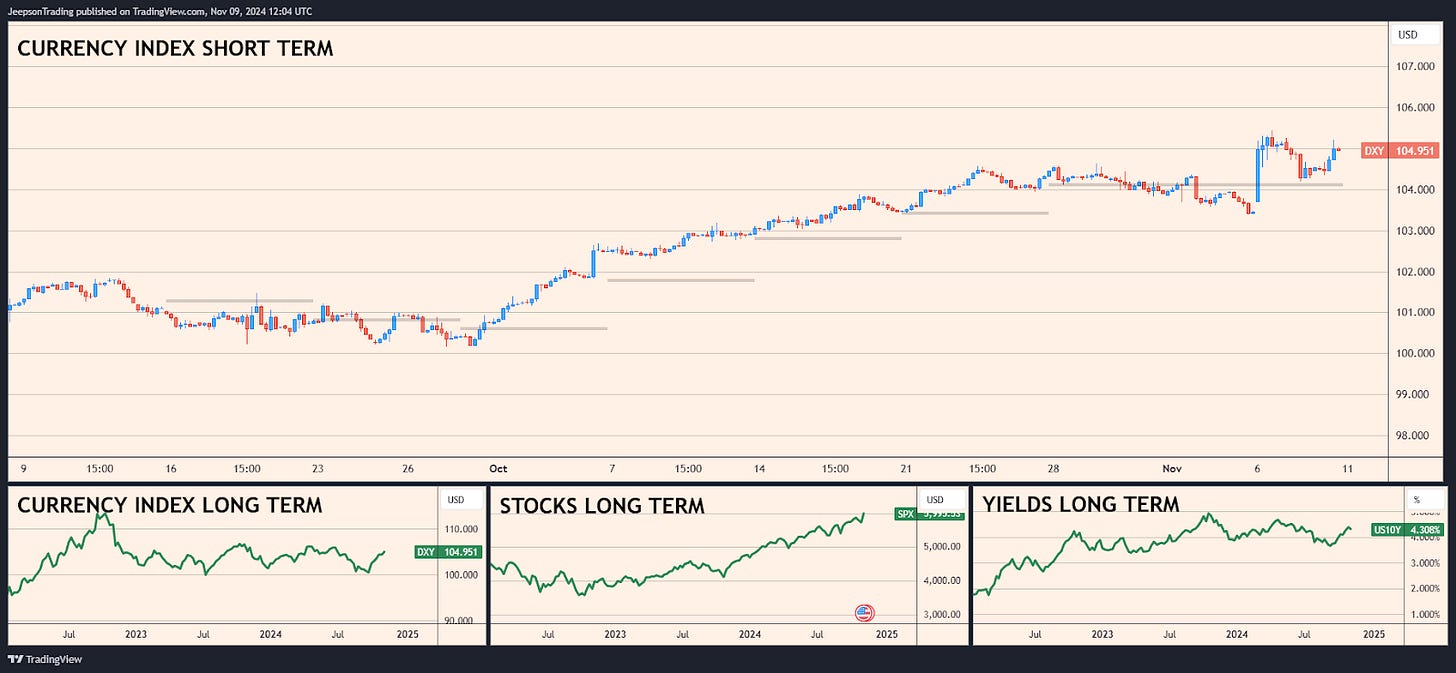Trump's Return Reshapes Dollar Dynamics
Saturday, November 09, 2024 (Week 45)
Navigating Post-Election Currency Markets
Welcome to our deep dive into the fundamental forces shaping the US Dollar following a transformative week in American politics. As forex traders digest Donald Trump's decisive victory and the Federal Reserve's recent 25-basis-point cut to 4.5%-4.75%, this analysis provides essential insights for navigating the evolving monetary landscape. With crucial inflation data and multiple Fed speeches scheduled for the upcoming week (November 13-15), understanding these fundamental shifts becomes particularly vital for currency positioning.
Republican Resurgence Reshapes Policy Expectations
The markets have experienced a seismic shift following Donald Trump's return to the presidency and Republican control of the Senate. During the week of November 4-8, this political revolution triggered the dollar's largest single-day move since March 2020, pushing the currency to four-month highs. Investors are rapidly repricing the implications of proposed policies, including potential tariffs of up to 60% on Chinese goods and significant fiscal expansion. The Dow Jones Industrial Average's remarkable 3.57% surge on November 6 - its strongest session since 2022 - underscores the magnitude of this market recalibration.
Monetary Policy Expectations Under Review
An intriguing counter-narrative has emerged as markets unwind previously aggressive rate cut expectations. Despite the Fed's November 8 decision to reduce rates by 25 basis points to 4.5-4.75%, strong economic data and anticipated inflationary pressures from Trump's proposed policies have led traders to reduce bets on future easing. The probability of a December rate cut has moderated to 91%, with markets now anticipating a more measured approach to monetary policy throughout 2025.
Global Power Dynamics: Geopolitical Forces and Currency Impact
The intersection of domestic political transformation and international relations presents a complex backdrop for dollar trading. Trump's victory has heightened focus on potential trade policy shifts, particularly regarding U.S.-China relations. While Middle East tensions between Israel and Iran initially supported the dollar's safe-haven status, recent reports suggesting Israel may avoid targeting Iranian oil infrastructure have moderated immediate geopolitical risk premiums.
Federal Reserve's Calculated Response: Monetary Policy in Transition
The Federal Reserve's influence on global currency markets faces a critical test as it navigates post-election dynamics. Chair Powell's November 8 statement emphasised the Fed's commitment to data-dependent decision-making, explicitly noting that the election results would not immediately impact policy decisions. The recent 25-basis-point cut follows September's larger 50-basis-point reduction, with markets now pricing in 42 basis points of total easing through year-end.
Economic Momentum Amid Political Change: Key Performance Metrics
GDP Growth (Q3 2024) Released: October 30 Actual: 2.8% annualised Expected: 3.0% Impact: Initial dollar weakness on the miss Next Release: November 29 (Q3 second estimate)
Employment Situation (October 2024) Released: November 1 Non-Farm Payrolls: 12,000 (Expected: 113,000) Unemployment Rate: 4.1% (Expected: 4.1%) Impact: Significant dollar volatility following the substantial payrolls miss Next Release: December 6
Inflation Metrics (September 2024) Released: October 13 Core CPI: 3.3% YoY (Expected: 3.2%) Impact: Dollar strengthened on higher-than-expected core inflation Next Release: November 13 (October data)
Consumer Activity (September 2024) Released: October 17 Retail Sales: +0.4% MoM (Expected: +0.3%) Impact: Supported dollar strength through evidence of resilient consumption Next Release: November 15
Market Correlations: Cross-Asset Dynamics
The post-election period has witnessed significant movements across asset classes, highlighting the dollar's complex relationships with other markets. Treasury yields have surged past 4.2%, reaching their highest levels since July, as investors price in the potential inflationary impact of Trump's proposed policies. Equity markets have reached historic highs, with the S&P 500 gaining 0.2% for the week ending November 8, while the Nasdaq 100 advanced 0.6%, reflecting optimism about potential corporate tax policies.
Dollar Dynamics: Currency Movements and Market Psychology
The U.S. Dollar's status as the world's reserve currency has taken on renewed significance following Trump's victory. The Dollar Index achieved its best monthly performance since 2022 in October, rising 3%, and has maintained momentum into November. The currency's response to political developments reflects both safe-haven demand and expectations of potentially inflationary policies.
Upside Catalysts Through Year-End
Implementation of protectionist trade measures
Above-consensus inflation readings (next release November 13)
Further moderation in rate cut expectations
Continued geopolitical uncertainty
Downward Pressure Points
Deteriorating international trade relations
Weaker-than-forecast economic data
Accelerated Fed easing timeline
Reduction in safe-haven demand
Strategic Implications and Forward Outlook
Trump's victory and Republican Senate majority fundamentally alter the policy landscape, creating potential inflationary pressures that could support dollar strength
Fed maintains strategic flexibility despite market pressure, with upcoming economic data critical for December rate decision
Dollar likely to remain supported by safe-haven flows and policy uncertainty through year-end
Sources:
Federal Reserve, Bureau of Labor Statistics, Bureau of Economic Analysis, U.S. Treasury, Bloomberg, Reuters, Trading Economics



